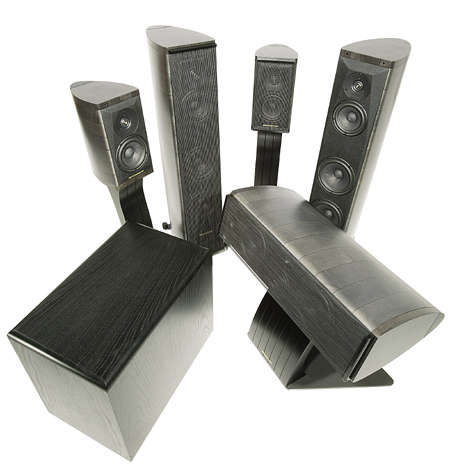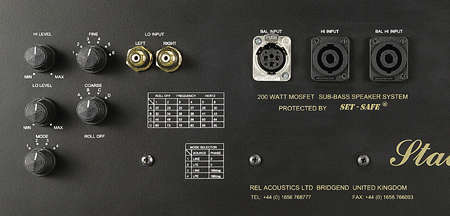Sonus Faber Cremona surround speaker system

Since its founding in 1980, Sonus Faber has won consistent accolades for its products. True to the sort of craftsmanship we expect from Italy, the company's speakers invariably feature over-the-top cabinetwork using solid woods, high-quality synthetic leather on the front baffles, and finishes polished to a high luster. Their models also have musical-sounding names: Guarneri Homage, Lineo Concerto, Amati Homage, and so on.
If all this sounds expensive, it is. The Cremona is Sonus Faber's latest floorstander, and if I call it a "bargain," the men in white coats will soon be coming to take me away. But for Sonus Faber, $7495/pair is something of a price breakthrough for a floorstanding design of this complexity. In appearance, the Cremona is almost a dead ringer for the Amati Homage, a Sonus Faber design dating from 1998. The Cremona is smaller, with a slightly less elaborate cabinet (a mixture of veneers and solid woods), and it uses different though no less advanced drivers. The Amati Homage is still available and sells for $22,000. A pair.
Sonus Faber has followed a different strategy with the Cremona, making sure from the get-go that the speaker is home-theater-friendly. The small stand-mounted Cremona Auditor serves nicely in a surround capacity. While the drivers in the Auditors are different from those used for the Cremona midrange and tweeter, they look the same, and more importantly, are a good acoustic match for the larger speaker over the operating range.
The surprise entry here is the 3-way Cremona Center. If you must use a horizontal center-channel speaker (and the market seems to demand them), the best design is a 3-way system with the drivers that cover most of the frequency range—the midrange and tweeter—mounted one above the other. That's how it's done here.
I've been following loudspeaker driver design as long as I've been using and reviewing speakers, and it would be a safe wager that the woofers and midranges here are from ScanSpeak, and the tweeter is from Vifa—both well-known and respected Danish driver manufacturers, now under common ownership. The woofers and mids employ paper cones with radial slits to minimize distortion and breakup. The tweeter is a ring-radiator model that resembles a tiny donut with a phase plug sticking out of its center. This new design—which Vifa and ScanSpeak seem to be making exclusively, at least for now—is showing up in speakers from a number of manufacturers. Exactly what benefits this design is supposed to provide are unclear from the driver manufacturers' and Sonus Faber's websites, but the latter avoids technobabble like the plague. We'll just have to let the tweeter speak—or sing—for itself.
The tall, deep, but narrow Cremona has a sculpted, lute-shaped cross section. This is not only for appearance, but to enhance rigidity and minimize standing waves inside the enclosure. It also comes with crossbraces that attach to the bottom of the narrow cabinet for added stability. The speaker is designed to be angled back slightly, and since that tilt can have a subtle but important effect on the sound, particularly with the first-order crossover filters the manufacturer uses, the adjustable spiked feet that fit into the braces are longer in front than in back. The spikes are rounded enough to make them safe to use, with care, on wood or tile floors, but they aren't sharp enough to penetrate carpets and thus firmly anchor the speaker to the surface beneath.
Each speaker in the Cremona system has a single set of high-quality binding posts—no biwiring here. Each also has Sonus Faber's signature grille design, consisting of dozens of black elastic strings stretched vertically. The strings provide a see-through appearance and resemble the strings of a violin—which I suspect was their inspiration. It's a unique and very attractive look.
But if you remove or reinstall the grilles, be very careful. It's easy to do, but a fair amount of stretching is involved, and if one end comes loose while you're pulling on the other, you could take a nasty whack. I recommend that you or someone else make certain that one end is held securely in place while the other is being maneuvered into position.
The Stadium III subwoofer from British subwoofer specialist REL is a heavy but not overly large, ported box containing a single heavy-duty 10-inch driver and 200W MOSFET amplifier. It has both high-level (speaker) and low- or line-level (balanced and unbalanced) inputs. The high- and low-level inputs have their own individual level controls, and both inputs can be used simultaneously. Phase settings of 0 and 180 are provided. The lowpass filter can be set to one of 24 discrete rolloff settings or defeated entirely, which is what you want to do when using the filter in your pre-pro or A/V receiver.
Setup
I set up the Cremonas in the positions I normally use for home theater speakers: the left and right fronts just beyond the edges of my 80-inch-wide Stewart projection screen and toed-in toward the listening position, the center located mid-screen and just below it. The top of the Center is just under 25 inches high on its dedicated stand; I had to raise my screen slightly to accommodate it. The surrounds were positioned at the rear of the room, with the REL subwoofer at the front, either in a corner or several feet out from it, along the front wall.

REL encourages the use of the high-level inputs with their subwoofers for the bass from the main channels. With their recommended setup, all of the 5 (or more) main speakers are driven full range. The subwoofer's high-level inputs get their signal by tapping into the L/R speaker outputs. The lowpass filter on REL is then set to a frequency close to the useful low-end limit of the L/R speakers, allowing the subwoofer to pick up the slack below that point. The Stadium III's highpass filter offers 24 options for this, ranging from 22Hz to 95Hz, but the most likely setting for a full-range, floorstanding speaker such as the Cremona will be in the 30–40Hz range. The LFE information is fed to the REL's low-level input from the pre-pro's subwoofer output. A separate level control on the REL is then used to set the LFE output relative to the main channel bass.
I'm not a fan of this arrangement. First, the center and surround speakers are provided no support from the subwoofer; set to Large, their bottom end extension will be subject to their own limits. Second, setting the subwoofer level may have to be done by ear, and while most audiophiles will be adept at doing this for the main channel bass, setting the LFE level relative to the main-channel bass by ear will be tricky at best. (A good 2-channel test CD, such as those offered by Stereophile, can help.) Third, and most important, the left and right main speakers are asked to carry the same main -channel bass as the subwoofer. This generally won't be a problem with music, but when you're talking about movie sound containing all manner of woofer-crunching low-frequency mayhem, you're asking for trouble when you feed it to any full-range speaker short of one with large, seriously heavy-duty woofers. The woofers in the Cremona are top-class units, but they're still only 6-inch drivers that haven't been designed for a slugging match with high-level, excursion-challenging frequencies below their effective lower limit—a limit that is higher than that of any subwoofer likely to be used with them.
For this reason, I did all but a little of my listening by driving the Stadium III subwoofer the way most subwoofers are used in a home theater: from the subwoofer output of the preamp-processor driving the sub at its low (line)-level, LFE input. I bypassed the REL's internal lowpass filter, and all of the crossover functions were handled in the pre-pro. None of the main-channel speakers were then required to deliver high-level bass significantly below 60 or 80Hz, the two pre-pro lowpass settings I tried. In my system, this arrangement produced the most open, clearly defined sound—the sound I report on here.
- Log in or register to post comments




































































